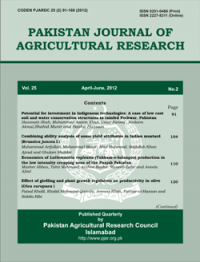DEVELOPMENT OF RESISTANT MAIZE GERMPLASM
Habib Iqbal Javed, Ashiq Saleem, Javed Fateh, Mozammil Hussain, Naheed Akhtar and Shamim-ul-Sibtain Shah*
ABSTRACT
During spring 1999, on the basis of survived plants, a total of 250 accessions including 150 exotic out of 350 and 100 indigenous out of 900 were selected. During autumn 1999, out of 250 accessions (progenies) 35 exotic and 10 indigenous could survive under artificial infestation. Under natural infestation, 100 progenies performed little better. The best plants among these progenies were advanced by self pollination. A total of 400 self pollinated cobs (as progenies) were screened during spring 2000 under natural infestation. The borer attack started at a very initial stage of the crop and swept down many of the progenies. Only 88 exotic and 7 indigenous progenies showed some resistance. The survived plants, among these progenies, were advanced by self pollination. During autumn 2000, only 9 progenies out of 95 showed some resistance with 35-66% plants survived under artificial infestation. Under natural infestation, 10 other progenies had more than 50% survived plants. The best survived plants among these 19 progenies were advanced by selfing. During spring 2001, 8 of the comparatively resistant germplasm showed no leaf damage while 9 others had 7.10 - 44.7% infestation. In checks, the infestation was from 27.9 to 100.0%. The selected materials were again maintained by self pollination to make pure lines. During autumn 2001, selected material was screened under double artificial infestation, first at 3-4 leaf stage of the crop and the second 10 days after first infestation with 15 newly hatched larvae per plant every time. Despite of double artificial infestation, 40.0-66.7% plants survived in the resistant germplasm but none survived in susceptible genotypes. Under natural infestation, 5 progenies had no damage while other showed 10.0-22.9% damage with intensity of 2-3 in resistant germplasm. The susceptible germplasm showed 30.0-66.6% infestation with intensity of 5-8. The dead hearts in resistant and susceptible germplasm were 0.0-7.8% and 19.6-25.4%, respectively. The performance of the resistant germplasm was far better than susceptible ones. The best plants in resistant germplasm were maintained by selfing to make them more uniform for resistance. During pollination, three resistant composite genotypes (BR-1, BR-2 and BR-3) were constituted by bulk pollination.
To share on other social networks, click on any share button. What are these?






